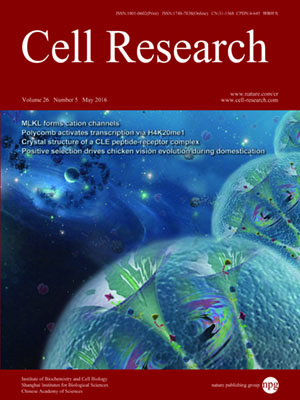
Volume 26, No 5, May 2016
ISSN: 1001-0602
EISSN: 1748-7838 2018
impact factor 17.848*
(Clarivate Analytics, 2019)
Volume 26 Issue 5, May 2016: 556-573
ORIGINAL ARTICLES
Positive selection rather than relaxation of functional constraint drives the evolution of vision during chicken domestication
Ming-Shan Wang1,3, Rong-wei Zhang7, Ling-Yan Su2,3, Yan Li1,3, Min-Sheng Peng1,3, He-Qun Liu1,3, Lin Zeng1,3, David M Irwin1,5,6, Jiu-Lin Du7, Yong-Gang Yao2,3, Dong-Dong Wu1,2 and Ya-Ping Zhang1,3,4
1State Key Laboratory of Genetic Resources and Evolution, Yunnan Laboratory of Molecular Biology of Domestic Animals
2Key Laboratory of Animal Models and Human Disease Mechanisms of the Chinese Academy of Sciences & Yunnan Province, Kunming Institute of Zoology, Kunming, Yunnan 650223, China
3Kunming College of Life Science, Unisversity of Chinese Academy of Sciences, Kunming, Yunnan 650204, China
4Laboratory for Conservation and Utilization of Bio-resource, Yunnan University, Kunming, Yunnan 650091, China
5Department of Laboratory Medicine and Pathobiology, University of Toronto, Toronto, Canada
6Banting and Best Diabetes Centre, University of Toronto, Toronto, Canada
7Institute of Neuroscience and State Key Laboratory of Neuroscience, Shanghai Institutes for Biological Sciences, Chinese Academy of Sciences, Shanghai 200031, China
Correspondence: Dong-Dong Wu, E-mail: wudongdong@mail.kiz.ac.cn; Ya-Ping Zhang,(zhangyp@mail.kiz.ac.cn)
As noted by Darwin, chickens have the greatest phenotypic diversity of all birds, but an interesting evolutionary difference between domestic chickens and their wild ancestor, the Red Junglefowl, is their comparatively weaker vision. Existing theories suggest that diminished visual prowess among domestic chickens reflect changes driven by the relaxation of functional constraints on vision, but the evidence identifying the underlying genetic mechanisms responsible for this change has not been definitively characterized. Here, a genome-wide analysis of the domestic chicken and Red Junglefowl genomes showed significant enrichment for positively selected genes involved in the development of vision. There were significant differences between domestic chickens and their wild ancestors regarding the level of mRNA expression for these genes in the retina. Numerous additional genes involved in the development of vision also showed significant differences in mRNA expression between domestic chickens and their wild ancestors, particularly for genes associated with phototransduction and photoreceptor development, such as RHO (rhodopsin), GUCA1A, PDE6B and NR2E3. Finally, we characterized the potential role of the VIT gene in vision, which experienced positive selection and downregulated expression in the retina of the village chicken. Overall, our results suggest that positive selection, rather than relaxation of purifying selection, contributed to the evolution of vision in domestic chickens. The progenitors of domestic chickens harboring weaker vision may have showed a reduced fear response and vigilance, making them easier to be unconsciously selected and/or domesticated.1
10.1038/cr.2016.44
FULL TEXT | PDF
Browse 2367


